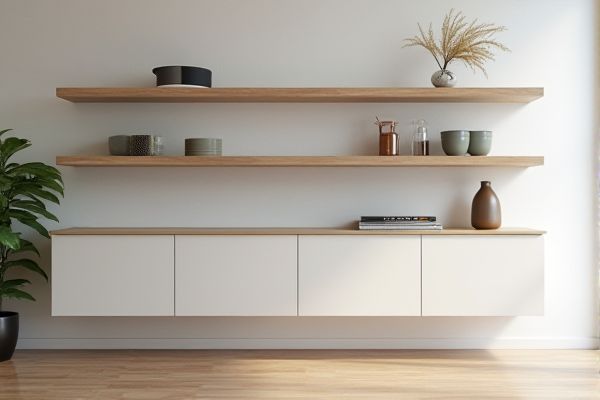
A floating shelf offers a minimalist, open storage solution that enhances room aesthetics and accessibility, while a wall-mounted cabinet provides enclosed storage, protecting items from dust and offering a tidier appearance. Discover which option suits Your space and lifestyle best by reading the rest of the article.
Table of Comparison
| Feature | Floating Shelf | Wall-Mounted Cabinet |
|---|---|---|
| Design | Open, minimalistic, modern | Enclosed, structured, traditional or modern |
| Storage Capacity | Limited, suitable for small items | High, ideal for bulky or multiple items |
| Installation | Simple, requires wall studs or anchors | Complex, heavier and needs secure mounting |
| Accessibility | Easy access, no doors | Protected storage, requires door access |
| Maintenance | Easy to clean and dust | Requires door hinges and surface cleaning |
| Cost | Generally affordable | Usually more expensive due to material and build |
| Use Cases | Decor display, books, small plants | Kitchen storage, bathroom items, office supplies |
Introduction: Floating Shelf vs Wall-Mounted Cabinet
Floating shelves offer a minimalist design with open storage ideal for displaying decor or frequently used items, enhancing room aesthetics without bulk. Wall-mounted cabinets provide enclosed storage space that conceals clutter, making them suitable for organized, hidden storage in kitchens or bathrooms. Choosing between the two depends on the desired balance between accessibility, visual appeal, and storage needs.
Design and Aesthetic Appeal
Floating shelves offer a minimalist and modern design that creates an open and airy atmosphere, making your space appear larger and less cluttered. Wall-mounted cabinets provide a more structured and substantial aesthetic, often featuring doors and panels that can complement traditional or contemporary decor styles. Choosing between the two depends on whether you prioritize sleek simplicity or functional cabinetry that blends seamlessly with your room's overall design.
Space Utilization and Storage Capacity
Floating shelves maximize space utilization by offering open storage that frees up floor area, making them ideal for small rooms and minimalist designs. Wall-mounted cabinets provide greater storage capacity with enclosed compartments, protecting items from dust and enabling organization of bulkier or less attractive belongings. Choosing between the two depends on the balance between visible display and concealed storage needs in a given space.
Installation Process and Difficulty
Floating shelves require simple installation involving brackets or cleats secured directly into wall studs, making them relatively easy for DIY projects. Wall-mounted cabinets demand more precise measurements, stud alignment, and additional hardware such as mounting plates and anchors, often requiring professional installation. The complexity of wall-mounted cabinets increases with their size and weight, necessitating careful leveling and secure fastening to ensure safety and stability.
Durability and Weight Support
Floating shelves offer minimalist appeal but generally support less weight due to limited anchoring points, making them ideal for lighter items and decorative displays. Wall-mounted cabinets, anchored directly into studs or masonry, provide superior durability and can securely hold heavier items such as kitchenware or electronics. Choosing between the two depends on your need for sturdy storage versus aesthetic space-saving solutions.
Material and Style Options
Floating shelves often feature materials like solid wood, metal, or glass, offering sleek and minimalist style options that blend seamlessly into modern interiors. Wall-mounted cabinets provide a broader variety of materials such as MDF, plywood, or engineered wood with laminate finishes, supporting diverse design styles from traditional to contemporary. Both floating shelves and wall-mounted cabinets can be customized with different colors, textures, and hardware to complement specific room aesthetics.
Cost Comparison
Floating shelves generally cost less than wall-mounted cabinets due to simpler materials and installation requirements, with average prices ranging from $20 to $100 per shelf. Wall-mounted cabinets, on the other hand, typically cost between $150 and $500 or more, depending on size, materials, and hardware complexity. Installation expenses for cabinets can also be higher, often requiring professional services, while floating shelves can often be installed by homeowners, reducing overall costs.
Maintenance and Cleaning
Floating shelves require minimal maintenance due to their open design, allowing easy access for dusting and cleaning with a soft cloth or duster. Wall-mounted cabinets often have doors and enclosed surfaces that can accumulate dust and fingerprints, necessitating more frequent wiping and occasional interior organization. Both options benefit from regular cleaning to prevent grime buildup, but floating shelves offer quicker upkeep because of their simpler structure.
Ideal Use Cases and Room Applications
Floating shelves are ideal for displaying decorative items or storing lightweight essentials, making them perfect for living rooms, bedrooms, or bathrooms where open access is desired. Wall-mounted cabinets provide concealed storage for heavier or bulkier items, enhancing organization in kitchens, offices, or utility rooms where maintaining a clean, clutter-free appearance is important. Your choice depends on whether you prioritize open display or hidden storage tailored to the room's function.
Pros and Cons of Floating Shelves and Wall-Mounted Cabinets
Floating shelves offer a minimalist design and easy accessibility, making them ideal for displaying decorative items or frequently used objects, but they have limited storage capacity and may struggle with heavy loads. Wall-mounted cabinets provide enclosed storage, protecting items from dust and offering more space for organization, though they often require professional installation and can occupy more visual space. Choosing between the two depends on storage needs, aesthetic preferences, and available wall support for weight-bearing.
 homyna.com
homyna.com